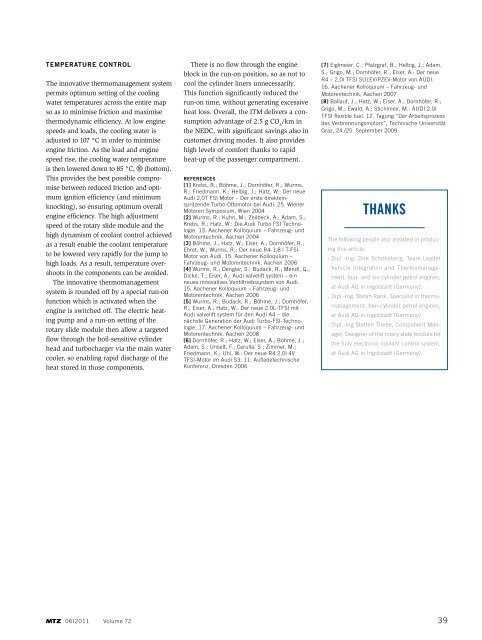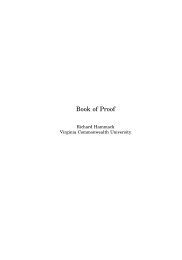THE NEW 1.8 L TFSl ENGlNE FROM AUDl PART 1: BASE ENGINE ...
THE NEW 1.8 L TFSl ENGlNE FROM AUDl PART 1: BASE ENGINE ...
THE NEW 1.8 L TFSl ENGlNE FROM AUDl PART 1: BASE ENGINE ...
You also want an ePaper? Increase the reach of your titles
YUMPU automatically turns print PDFs into web optimized ePapers that Google loves.
temperature control<br />
The innovative thermomanagement system<br />
permits optimum setting of the cooling<br />
water temperatures across the entire map<br />
so as to minimise friction and maximise<br />
thermodynamic efficiency. At low engine<br />
speeds and loads, the cooling water is<br />
adjusted to 107 °C in order to minimise<br />
engine friction. As the load and engine<br />
speed rise, the cooling water temperature<br />
is then lowered down to 85 °C, ⑩ (bottom).<br />
This provides the best possible compromise<br />
between reduced friction and optimum<br />
ignition efficiency (and minimum<br />
knocking), so ensuring optimum overall<br />
engine efficiency. The high adjustment<br />
speed of the rotary slide module and the<br />
high dynamism of coolant control achieved<br />
as a result enable the coolant temperature<br />
to be lowered very rapidly for the jump to<br />
high loads. As a result, temperature overshoots<br />
in the components can be avoided.<br />
The innovative thermomanagement<br />
system is rounded off by a special run-on<br />
function which is activated when the<br />
engine is switched off. The electric heating<br />
pump and a run-on setting of the<br />
rotary slide module then allow a targeted<br />
flow through the boil-sensitive cylinder<br />
head and turbocharger via the main water<br />
cooler, so enabling rapid discharge of the<br />
heat stored in those components.<br />
06I2011 Volume 72<br />
There is no flow through the engine<br />
block in the run-on position, so as not to<br />
cool the cylinder liners unnecessarily.<br />
This function significantly reduced the<br />
run-on time, without generating excessive<br />
heat loss. Overall, the ITM delivers a consumption<br />
advantage of 2.5 g CO 2 /km in<br />
the NEDC, with significant savings also in<br />
customer driving modes. It also provides<br />
high levels of comfort thanks to rapid<br />
heat-up of the passenger compartment.<br />
references<br />
[1] Krebs, r.; Böhme, J.; Dornhöfer, r.; Wurms,<br />
r.; Friedmann, K.; Helbig, J.; Hatz, W.: Der neue<br />
Audi 2,0T FSI Motor – Der erste direkteinspritzende<br />
Turbo-Ottomotor bei Audi. 25. Wiener<br />
Motoren Symposium, Wien 2004<br />
[2] Wurms, r.; Kuhn, M.; Zeilbeck, A.; Adam, S.;<br />
Krebs, r.; Hatz, W.: Die Audi Turbo FSI Technologie.<br />
13. Aachener Kolloquium – Fahrzeug- und<br />
Motorentechnik, Aachen 2004<br />
[3] Böhme, J.; Hatz, W.; Eiser, A.; Dornhöfer, r.;<br />
Ehret, W.; Wurms, r.: Der neue r4-1,8 l T-FSI-<br />
Motor von Audi. 15. Aachener Kolloquium –<br />
Fahrzeug- und Motorentechnik, Aachen 2006<br />
[4] Wurms, r.; Dengler, S.; Budack, r.; Mendl, G.;<br />
Dicke, T.; Eiser, A.: Audi valvelift system – ein<br />
neues innovatives Ventiltriebssystem von Audi.<br />
15. Aachener Kolloquium – Fahrzeug- und<br />
Motorentechnik, Aachen 2006<br />
[5] Wurms, r.; Budack, r.; Böhme, J.; Dornhöfer,<br />
r.; Eiser, A.; Hatz, W.: Der neue 2.0l-TFSI mit<br />
Audi valvelift system für den Audi A4 – die<br />
nächste Generation der Audi Turbo-FSI-Technologie.<br />
17. Aachener Kolloquium – Fahrzeug- und<br />
Motorentechnik, Aachen 2008<br />
[6] Dornhöfer, r.; Hatz, W.; Eiser, A.; Böhme, J.;<br />
Adam, S.; unselt, F.; Cerulla, S.; Zimmer, M.;<br />
Friedmann, K.; uhl, W.: Der neue r4 2,0l 4V<br />
TFSI-Motor im Audi S3. 11. Aufladetechnische<br />
Konferenz, Dresden 2006<br />
[7] Eiglmeier, C.; Pfalzgraf, B.; Helbig, J.; Adam,<br />
S.; Grigo, M.; Dornhöfer, r.; Eiser, A.: Der neue<br />
r4 – 2,0l TFSI SulEV/PZEV-Motor von AuDI.<br />
16. Aachener Kolloquium – Fahrzeug- und<br />
Motorentechnik, Aachen 2007<br />
[8] Ballauf, J.; Hatz, W.; Eiser, A.; Dornhöfer, r.;<br />
Grigo, M.; Ewald, A.; Stichlmeir, M.: AuDI 2.0l<br />
TFSI flexible fuel. 12. Tagung “Der Arbeitsprozess<br />
des Verbrennungsmotors”, Technische universität<br />
Graz, 24./25. September 2009<br />
ThAnKS<br />
The following people also assisted in producing<br />
this article:<br />
: Dipl.-Ing. Dirk Schöneberg, Team leader<br />
Vehicle Integration and Thermomanage-<br />
ment, four- and six-cylinder petrol engines,<br />
at Audi AG in Ingolstadt (Germany).<br />
: Dipl.-Ing. Stefan rank, Specialist in thermo-<br />
management, four-cylinder petrol engines,<br />
at Audi AG in Ingolstadt (Germany).<br />
: Dipl.-Ing Steffen Triebe, Component Man-<br />
ager, Designer of the rotary slide module for<br />
the fully electronic coolant control system,<br />
at Audi AG in Ingolstadt (Germany).<br />
39

















